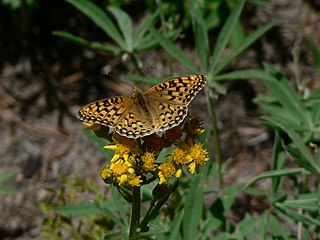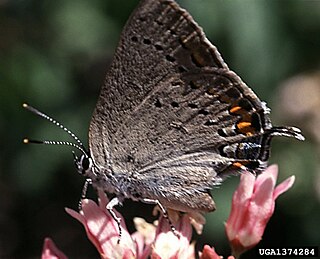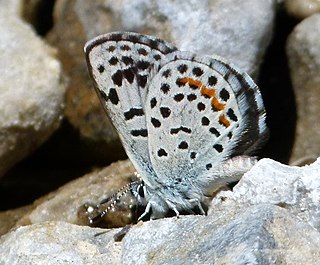
Speyeria zerene, the zerene fritillary, is a butterfly found in the western portions of the United States and Canada. The species was first described by William John Swainson in 1827.

Euphilotes is a genus of butterflies in the family Lycaenidae, which consists of a number of species found in western North America. Some of the species are endangered, such as the Smith's blue, Euphilotes enoptes smithi.

Smith's blue butterfly, Euphilotes enoptes smithi, is an subspecies of butterfly in the family Lycaenidae. This federally listed endangered subspecies of Euphilotes enoptes occurs in fragmented populations along the Central Coast of California, primarily associated with sand dune habitat in one case with a dune-based Maritime Coast Range Ponderosa Pine forest in the Carbonera Creek watershed in Santa Cruz County. The range of E. e. smithi is from Monterey Bay south to Punta Gorda.

Boloria chariclea, the Arctic fritillary or purplish fritillary, is a butterfly of the family Nymphalidae. It is found in the northern parts of the Palearctic and Nearctic realms.

Icaricia lupini, the lupine blue, is a butterfly of the family Lycaenidae. It is found from south-western Canada, south through much of mountainous and intermountain western United States and high plains to northern Mexico.

Calephelis perditalis, the rounded metalmark or lost metalmark, is a butterfly in the family Riodinidae. It is found in Texas in the United States and Mexico, south to Venezuela. The species was first described by William Barnes and James Halliday McDunnough in 1918.

Satyrium californica, the California hairstreak, is a butterfly of the family Lycaenidae. It is found from British Columbia south to southern California and east to Colorado.

Ochlodes sylvanoides, the woodland skipper, is a butterfly of the family Hesperiidae. It is found in North America from British Columbia south to southern California, east to Montana, Colorado and Arizona.

Euphilotes battoides, the square-spotted blue or buckwheat blue, is a species of butterfly of the family Lycaenidae. It is found in western North America from Washington south to Baja California Norte and then west to southern Colorado and New Mexico.

Euphilotes pallescens, the pale blue, pallid blue or pallid dotted blue, is a species of butterfly of the family Lycaenidae. It is found in the United States in southeastern California, Nevada, southern Utah and northern Arizona.

Euphilotes ancilla, the Rocky Mountain dotted blue, is a species of butterfly of the family Lycaenidae. It is found from Washington south to California and southern Alberta and Saskatchewan south through the Rockies and high plains to Wyoming, Colorado, Utah, and northwestern New Mexico. The species was first described by William Barnes and James Halliday McDunnough in 1918.

Satyrium behrii, the Behr's hairstreak, is a butterfly of the family Lycaenidae. It is found in western North America from western Texas north and west through New Mexico, Arizona, and southern California to British Columbia.
Rekoa marius, the Marius hairstreak, is a butterfly in the family Lycaenidae. It is found from Paraguay north to Sonora in Mexico. Strays may be found as far north as southern Texas. The species used to be considered rare in the southern Texas. It is the species of Rekoa found in Arizona. The habitat consists of disturbed tropical areas.

Hemiargus ceraunus, the Ceraunus blue, is a butterfly in the family Lycaenidae. The species was first described by Johan Christian Fabricius in 1793. It is found in the southwestern United States, southern Texas, Florida and the Florida Keys south through the West Indies, Mexico and Central America to South America. Strays may be found in North Carolina, Missouri, Kansas and Nevada. The habitat consists of open woodland, desert scrub, dunes, pastures, road edges and vacant lots.

Ministrymon clytie, the Clytie hairstreak, is a butterfly of the family Lycaenidae. It was described by William Henry Edwards in 1877. It is found from southern Arizona, New Mexico and Texas to Mexico, Guatemala and Costa Rica. The habitat consists of tropical forest openings and subtropical thorn forests.
Chlorostrymon telea, the telea hairstreak, is a butterfly of the family Lycaenidae. It was described by William Chapman Hewitsonin 1868. It is found from southern Texas and Mexico to Colombia, Uruguay, Paraguay, eastern Bolivia, Argentina and Chile. The habitat consists of stream valleys of semideciduous dry forests.

Callophrys spinetorum, the thicket hairstreak, is a butterfly of the family Lycaenidae. It was described by William Chapman Hewitson in 1867. It is found in North America from British Columbia through the Rocky Mountains to New Mexico and Mexico and through California to Baja California. The habitat consists of pinyon-juniper forests, mixed woodlands, and coniferous forests.
Satyrium polingi, or Poling's hairstreak, is a butterfly of the family Lycaenidae. It was described by William Barnes and Foster Hendrickson Benjamin in 1926. It is found in North America from southern New Mexico and western Texas south to north-eastern Mexico. The habitat consists of oak woodlands.

Chlosyne californica, the California patch, is a butterfly of the family Nymphalidae found in the Southwestern United States and Mexico. It lives in desert washes and canyons in regions between southern Nevada south to southwestern Arizona, southeastern California, Baja California and Sonora.
Euphilotes bernardino, the Bernardino blue, is a butterfly in the family Lycaenidae. The species was first described by William Barnes and James Halliday McDunnough in 1916. It is found in North America.

















